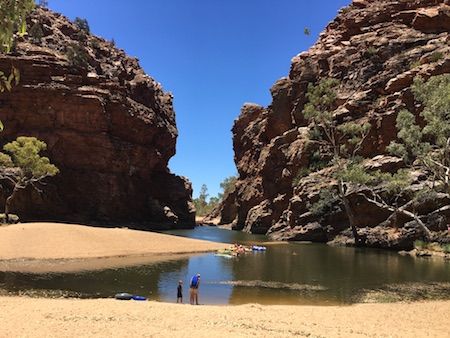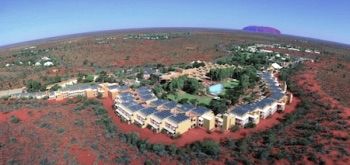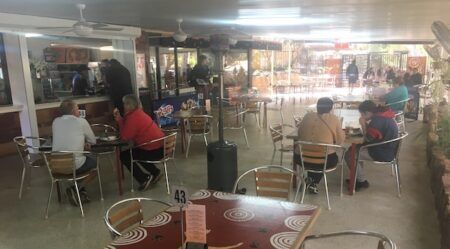Mereenie road seal crucial for tourism recovery
26 July 2020
 By ERWIN CHLANDA
By ERWIN CHLANDA
“The industry is on its knees. We are basically in our darkest hour.”
Patrick Bedford (pictured) became chairman of Tourism Central Australia (TCA) three months ago as the region’s major private enterprise slammed into its greatest ever crisis.
He was soon joined by Danial Rochford as the CEO, a newcomer to the region, from Queensland, here on a three year contract.
The task for this new management is formidable.
The organisation faced local media on Friday, in front of the visitors’ centre in the Mall, together with members each holding a sheet with a single letter.
They lined up to spell: “SEAL THE LOOP.”
This is TCA’s major drive to survive COVID-19.
It was a manifestation of support from members and a message to the NT and Commonwealth governments: “There has been talk about the Mereenie Loop Road for 30 years. No more talk. We need action,” said Mr Bedford.
He was referring to the 125 kilometre unsealed section between King’s Canyon and Hermannsburg.
When completed motorists will be able to travel from Ayers Rock Resort to Alice Springs all the way on bitumen, through some of The Centre’s most magnificent country, rather than on the boring Lasseter and Stuart highways.
What’s more, it will put meaning into the concept of The Rock being an asset to The Alice rather than a destructive competitor.
The objective is to entice tourists, after visiting The Rock, to stay in the western Alice region for five to seven days.
The Inner Loop (Alice, Hermannsburg, Palm Valley, Gosse’s Bluff, Glen Helen, the West MacDonnell Ranges, back to Alice) is sealed already.
Sealing the new section to the south-west will complete the Red Centre Way, also forming a portion of the Outback Way between Queensland and WA, whose sealing has been a major demand from politicians in The Centre.
Mr Bedford says the cost of the Loop seal has been estimated at $180m.
It’s ironic that as this industry is calling for spending on roads, the Gunner Government has spent $90m on not just “one road to nowhere” but two.
So says Dr Don Fuller, economic researcher on major project developments in the NT.
 These roads were built in the Top End, says Dr Fuller, in anticipation of a massive aquaculture project, Sea Dragon.
These roads were built in the Top End, says Dr Fuller, in anticipation of a massive aquaculture project, Sea Dragon.
It faltered for lack of funding, including the refusal of a loan from the $5 billion Northern Australia Infrastructure Facility.
In his report Dr Fuller wrote: “Presumably the Commonwealth is … more cautious about building high cost roads in remote regions to no particular place or for no particular purpose.
“Commercial operations are required to satisfy the owners of their company that a financing decision is likely to have a positive economic and commercial outcome.
“No such constraints appear to act on the financial decisions of the Gunner government.”
(Mr Gunner has not responded to a request for comment from the Alice Springs News. We will publish it as an update if we receive one. UPDATE: See below.)
Mr Bedford names the national Aboriginal art gallery in Alice Springs as essential project number two.
There has been too much debate about it, he says: “Just get on with it. We want it in the CBD area to reinvigorate it.”
TCA will hold a tourism summit in Alice Springs before the election – date yet to be announced – to consider “what are the big projects from a world class standpoint” will be.
“It’s what’s going to put Alice Springs back on the map, next with Uluru.”
NEWS: What about the competition between the Ayers Rock Resort and Alice Springs? Both are line-ball with their earnings from tourism yet Alice Springs has a population of 25,000 while the resort has around 350, is owned by an interstate company that repatriates its profits.
BEDFORD: At the end of the day we need to work hand in hand with Uluru. We’re lucky that it is classed as one of the Seven Natural Wonders [of Australia]. We just need to diversify the market out from that. When the Rock was busy over the last couple of years they were at capacity. They wanted people to come in and go, for the turn-over.
NEWS: How will that change?

BEDFORD: If we can get them to come through the Mereenie Loop – two nights at Uluru, down into King’s Canyon, which is just as spectacular in my opinion, then into Hermannsburg and Palm Valley. That is going to draw people into Alice Springs where we’ll have the national Aboriginal art gallery and the other local attractions. And we’re lucky that we have a really good domestic airport here. We have the perfect infrastructure to create the next big thing for Central Australia which is the Red Centre Way, once it’s fully sealed.
Says Mr Rochford: “From a marketer’s perspective that’s going to be one of the world’s great drive destinations. If we do it right we’ll have something very special.”
NEWS: Are there indications of private investment, for example three star wilderness lodges in the West Macs?
BEDFORD: Once there is an announcement of the Loop being sealed, indicating the volume of people coming through there, we will need to work out what infrastructure is needed. There has been research about a hotel at Hermannsburg. There is Glen Helen.
NEWS: What assurances would need to be given to potential investors?
 BEDFORD: The West MacDonnells regions are Aboriginal owned lands. One of the big tasks we have is to re-identify Central Australia as a place for Indigenous tourism. It’s one of our biggest drawcards. Tourists come to Uluru for the culture. We as a location need to broaden this out. Aboriginal owned Standley Chasm (cafe pictured) is doing a great job, as an example. We need more of that.
BEDFORD: The West MacDonnells regions are Aboriginal owned lands. One of the big tasks we have is to re-identify Central Australia as a place for Indigenous tourism. It’s one of our biggest drawcards. Tourists come to Uluru for the culture. We as a location need to broaden this out. Aboriginal owned Standley Chasm (cafe pictured) is doing a great job, as an example. We need more of that.
Asked whether there are negotiations with the Aboriginal owners of the national park for substantial private investment in resorts, including long-time security of land leases, Mr Bedford said this is “definitely” on the agenda: “There needs to be more capacity out there.”
Mr Rochford says: “Everything has to be done in co-operation with Aboriginal people. We don’t want friction.”
The involvement by Indigenous people should range “from a walking tour to a major operation”.
How could private investors become involved in tourism in the national parks?
“I think it would be something similar to model the Ayers Rock Resort has,” says Mr Bedford.
As the “primary tour operator” in the West Macs he is well-placed to have an overview of these issues.
He has built up his business, Emu Run, over 15 years to now include more than 16 vehicles, from coaches to 4WDs, and two accommodation houses in Alice Springs, the Alice Motor Inn and Alice Lodge.
He is a member of the West MacDonnell Ranges and Hermannsburg Tourism Action Committee. It represents businesses including in Standley Chasm, Hermannsburg (where a $3m upgrade is under way) and Glen Helen.
Mr Bedford says all have a strong interest in the Red Centre Way.
The board helps to identify their plans, prevents them from crossing each-others’ paths and supports the growth of tourism in this region.
PLEASE NOTE: The earlier version of this report published yesterday inadvertently appeared in a format not permitting readers’ comments. We’re looking forward to your views in the comment box below and we hope you are enjoying our new look! Erwin Chlanda, Editor.
UPDATE August 6:
We put questions to Chief Minister Michael Gunner about project Sea Dragon and received answers, which in turn were responded to by Dr Fuller. Find HERE that exchange, and Dr Fuller’s examination of the project.



“No more talk. We need action,” said Mr Bedford.
Reminds me of a graffiti mentioned in a book by Eduardo Galeano: “Basta de hechos. ¡Queremos promesas!” (Enough of deeds. We want promises!)
Sealing of the Tanami Road from the Stuart Highway turn-off to Yuendumu was first mooted by the Federal Department of North Australia in 1973.
Their optimistic proposal included: “Sealing the four road sections proposed for the Centre will also facilitate greater involvement and participation of local communities in their own economic and social development.”
Depending on how you define “greater involvement,” it didn’t really happen and 10 Km remains to be sealed.
Perhaps we should have stood in line with single letter placards spelling: “THE TANAMI”
@ Frank Baarda (27 July 2020 At 7:10 am): So much can be said about 1973 but, critically, it was the year the economies of the West (including Australia) plunged into recession for the first time since the 1930s.
Therein lies the reason why the grand plan for sealing Centralian regional roads from the first year of the Whitlam Government vanished into the ether.
The first local politician I know of to call for the sealing of the Tanami Road (and also the Plenty Highway) was Tony Greatorex, the Member for Stuart, in 1966.
It was also that year that a tour party from Western Australia travelled to The Centre via the Gunbarrel Highway and Uluru, promoting this route as a potential tourism drawcard.
The sealing of the outer Mereenie Loop Road was recommended in a major tourism study for Central Australia released by the NT Government in November 1989, coincident with the National Pilots’ Strike that was crippling the tourism industry nationwide (not least in the NT) and as the national economy was teetering on the brink of the early 1990s recession.
Chief Minister Marshall Perron observed at the time that it would be many years before the sealing of the Mereenie Loop roads would be achieved.
Perhaps we should pinch a line from Banjo Paterson’s poem “The Travelling Post Office” and adopt it as The Centre’s motto: The land of lots’o time.
@ Alex Nelson. Thank you for that (I like being corrected – it is one way to learn stuff).
The first lot on the Yuendumu stretch of the Tanami Road (formerly the Tanami Track) to be sealed was 90 km. Then after a pause they did another 30 km to be followed again after a significant pause by 10 km.
Mercifully they broke the mould otherwise we’d have had 3 km, 1 km, 300 m, 100 m and so on and by now they’d be doing 30 cm.
@ Frank Baarda: Ah yes, and with official ribbon-cutting ceremonies for each stage, too! (Any excuse for a party).
Still no long term vision for the centre but bits and pieces here and there.
We are in the unique position of having a North South major route, a potential major east west major route, a major north west – south east food to market corridor, a north south railway and an internationally rated airport – all co-located just south of the town, if we choose to utilise that situation.
But we don’t and insist on squabbling over what are relatively minor issues instead of the national interests both for tourism infrastructure and defence.
My choice is the Tanami, followed by the Plenty.
Bringing the outback way in via Gemtree, Arltunga and perhaps Santa Teresa would open up a completely new East Macs tourism province, or perhaps the bedded in tourism industry is frightened of that prospect.
The CBD has had its day as a tourism precinct no matter how much money goes in.
Good as a retail precinct, but build up a new core between The Gap and the airport based around the Transport Hall of Fame and a Cultural Centre and what is Indigenous to the area, just as Winton and other places have done.
And let’s move into the new current era. No one comes here to look at our high rise. Or new residential developments.
Yes. Seal the loop. It will generate income for the region a hundred times over. It will also bring jobs. Better value than the gallery. Infrastructure always pays off so handsomely.
@ Trevor Shiell: Yes, indeed “the big picture”.
You state that “My choice is the Tanami”.
Back in 1976 the Aboriginal owned Yuendumu Mining Co (YMC) made a submission to a Parliamentary Standing Committee on Public Works in which we urged that the sealing of the Tanami Road be given priority because of social, economic and strategic considerations.
It was admitted that tourism was (at the time) a minor consideration as far as the Tanami Road was concerned, but in all other aspects the Tanami Road offered the greatest potential.
What was emphasised in the submission was the counter-intuitive fact that the closest rail head to the Kimberleys was Alice Springs and not Perth.
Broome is almost 700 km closer to Alice Springs than to Perth.
YMC aspired to become a supplier of sealing aggregate for the Tanami Road, which never happened, not for lack of trying.
I tried to manage YMC for over four decades. I retired on YMC’s 50th Anniversary and half a year later YMC went into liquidation.
I think that sealing the Loop would detract very much from the adventure of the outback.
The wildlife would not be as visible as it currently is.
Similarly, sealing the Great Central road would also be another mistake. I have driven the Great Central many times and chose to do so for the remoteness of the trip.
I could have driven the Eyre Highway, but driving on bitumen is boring and mind-numbing and there is a tendency to zone out, which has inherent dangers.
At least on a dirt road, you tend to stay alert and look at the beautiful surrounds.
On the other hand, the Tanami Road is a slightly different story as it is used for commercial purposes.
Tourism in the outback is an adventure and will not be determined by sealed roads.
Great idea to re-boot Central Oz tourism and create jobs.